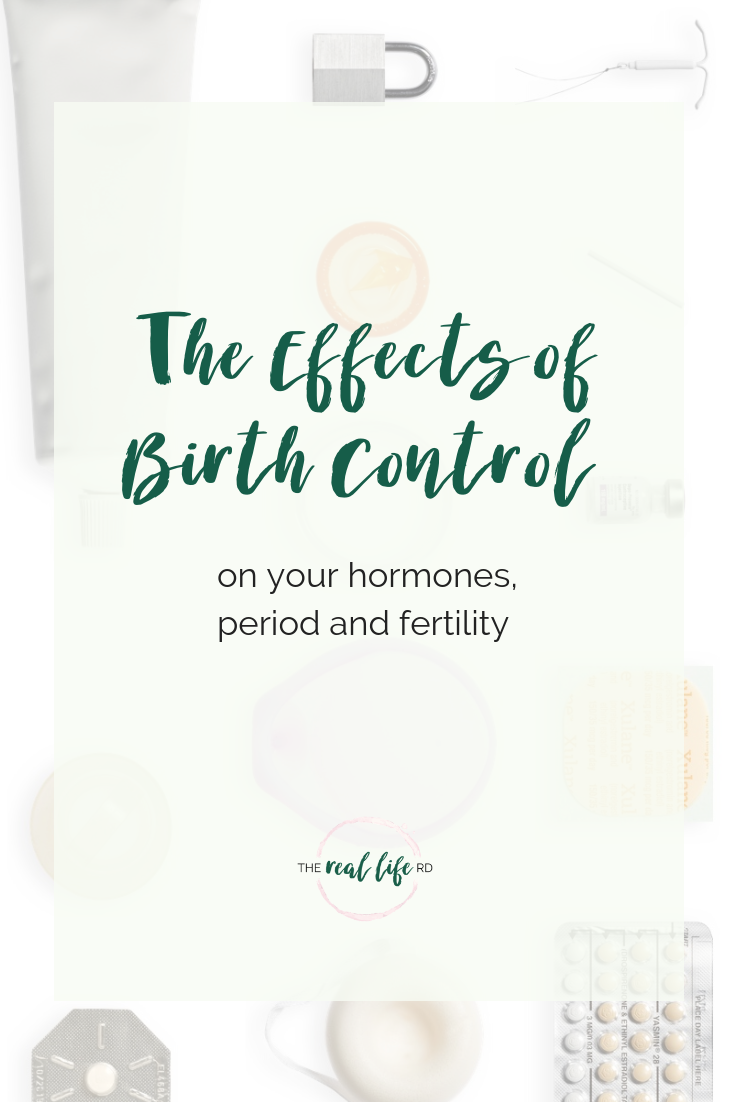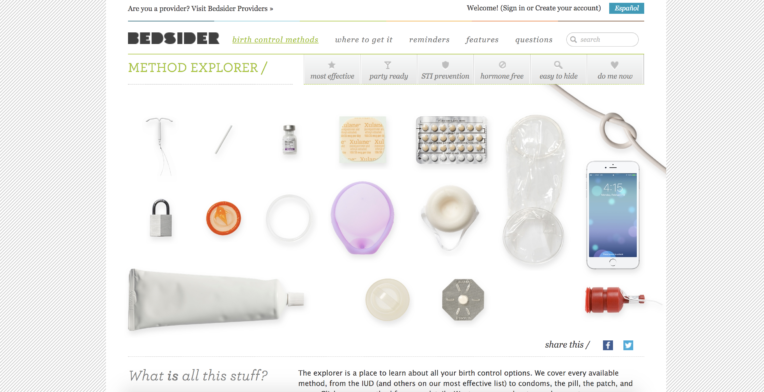Reproductive health is a touchy subject because it is so personal, intimate and vulnerable. Politics and religion are also involved. This post is not meant to be a sociopolitical or religious conversation, or a position on women’s rights or feminism, nor am I trying to tell you what to do with your own reproductive health. My goal is to simply educate. It’s your right to know all your options so you can make a decision that is right for YOU. I hope this post is helpful for you, where ever you are <3

Birth control is prescribed for a variety of reasons, but rarely are women fully informed on all their options and the pros and cons of each option. I’m not sure why. Perhaps it’s the limited amount of time health care providers (HCPs) have with patients, HCP bias (we all carry bias), laziness….I’m not sure. But we should be more informed than we actually are.
Birth control is prescribed for contraceptive purposes, which is what it’s meant for. But it’s also often prescribed for symptom management – from PMS to acne to heavy periods to PCOS and much more. Women aren’t given alternatives so it seems birth control is the only option to help them manage these very uncomfortable and sometimes embarrassing symptoms. If that was my only option and I was told the pros and not the cons, you better believe I’d be saying yes to the prescription too!
The thing is though, once birth control is stopped these symptoms emerge again. I was told to take birth control to “regulate my period” when in reality, my body didn’t know how to menstruate on its own for 10 years, but the birth control was masking this problem. When I wasn’t on birth control, I didn’t get a period. I also didn’t know the “period” I was getting on birth control was actually a withdrawal bleed, not a physiological period. That’s my story. I get messages and emails from women every day sharing their symptoms are unmanageable when not taking birth control. If you have acne, this post and this post will be helpful to read. If you have PCOS, this series of blog posts will be helpful. If you’re not getting a period, read here. If you have irregular periods, read here. If you have long cycles, read here. If you have short cycles, read here. I need to write a PMS post (I have, but need to update it so it’s archived for now) and a post on endometriosis and fibroids so stay tuned for that.
This post is about your options for contraception. I am not pro or anti birth control. I prescribe birth control. I’m simply pro informed consent so you can make a decision that is best for you. Your HCP can be a support and resource for you as you navigate health care decisions that impact your reproductive health. These choices are important. You should feel supported, respected and cared for by your provider. But even if you don’t and you feel swayed one way or another, know you have full autonomy over your health.
This post could be thousands and thousands of words long (and I’m over 3000) so this will in no way be a comprehensive post covering all the ins and outs of birth control – side effects, cost, etc. But I hope this post serves as a quick reference guide to many options out there for birth control and speaks to the major pros and cons of each that you can’t easily understand with a quick google.
There are SO MANY BIRTH CONTROL OPTIONS. It’s fantastic there are so many to choose from! But it can become quickly confusing when it comes to making a choice.
To simplify, think of your options in three different tiers. I like to break it down like this:
- Hands Off & No User Error
- Hands On & Some User Error
- On Demand & Most User Error
Hands off options you don’t have to think about and have no user error (meaning you can’t “mess it up”) and therefore those options will be most effective. IUDs, the implant and sterilization (vasectomy/tubes tied) fall into this category. You get these inserted or the procedure done and you don’t have to think about birth control for years. These are more than 99% effective.
Hands on options you do have to think about, therefore they will be a little less effective since there’s room for more user error. These options include the birth control pill, the patch, the ring and the shot. You either need to do something daily, weekly, monthly or every few months. These are still pretty effective at 91-94% but not as effective as the hands off options.
On demand options are those you can use anytime and don’t need a prescription for. I’m including in this category withdrawal, condoms*, fertility awareness methods, and lactational amenorrhea. These options CAN be highly effective if used diligently. So it’s not that they aren’t effective, it’s just there there is a lot of room for user error. In addition to one hormone free IUD option, these options are also hormone free.

Below are some of the major pros and cons – particularly the amount of hormone going into your body, the effect on your period and the effect on your fertility. To get informed about the side effects, cost, how to use the method, and other details of each option go check out bedsider.org. It is a wonderful and incredibly user friendly resource if you’re looking into birth control options. Use what info resonates with your belief systems and leave what doesn’t. The website also has information about less frequently used options like the diaphragm, cervical cap, etc. along with various articles and videos from real life people sharing about their experience with various methods. Fun fact: I recognized a couple people from my nursing program at Columbia in the videos!
Ok, let’s jump into all these choices.

**if you are breastfeeding, you’ll want to avoid any birth control method containing estrogen for the first couple months (or longer, every woman has a different response) …here is a great evidence based post on birth control and breastfeeding if you want to learn more
IUDs
You’ve got two categories here: hormonal and non-hormonal.
Hormonal options in the US include Skyla, Kyleena, Liletta and Mirena.
The Hormone Situation –> These all contain a synthetic progesterone (aka progestin) called levonorgesterel. Skyla has the lowest dose and Liletta and Mirena have the highest doses. Kyleena is in the middle. Overall though, in any of them, it’s still a very small dose of hormone. The progestin is released locally in your uterus where the device is inserted, so very little actually gets into your bloodstream which is a huge plus. There is no synthetic estrogen in IUDs.
The Effect on Your Period Situation –> These IUDs can, but often don’t, suppress ovulation – therefore many women still ovulate with IUDs in place which is another positive. The cascade of hormones that causes you to ovulate each month isn’t completely disrupted like it is with other method. The biggest side effect with your period is lighter or missing periods and irregular spotting.
The Return to Fertility Situation –> Most women resume ovulating soon after the IUD is removed assuming there wasn’t an underlying issue with your period before the IUD was inserted. You can get an IUD removed anytime.
The non hormonal option is Paragard.
The Hormone Situation –> There are no hormones in Paragard, instead it’s a copper containing IUD. Since there are no hormones, your own hormones are not affected.
The Effect on Your Period Situation –> No hormones means you continue ovulating as usual. The biggest effect on your period is heavier, longer periods – the opposite of hormonal IUDs. In most women this resolves in a few months and periods lighten back up to normal. But for some women, heavier & longer periods continue for the entire time Paragard is inserted.
The Return to Fertility Situation –> Since hormones weren’t affected in the first place, you should continue ovulating as you usually would when the IUD is removed.
The Implant
You’ve got one option here in the US, Nexplanon.
The Hormone Situation –> This implant which is about the size of a match and inserted underneath the skin in your arm contains only a synthetic progesterone like the IUD, but this one is called etonogestrel. It has a higher dose of hormone than the IUDs and the hormone is released into your bloodstream. Again, no estrogen in the implant.
The Effect on Your Period Situation –> You won’t ovulate with the implant. The progestin in the implant prevents ovulation by making your body think it’s already released an egg so you don’t release another egg. For the first 6-12 months most women experience a fair amount of irregular bleeding – for some women it resolves within a year and for others it continues the whole time the implant is in place.
The Return to Fertility Situation –> Compared to IUDs, return to fertility can be slightly slower, but still rather quick. Most women resume ovulating within a month or two after the implant is removed assuming there wasn’t an underlying issue with your period before the implant was inserted. You can get Nexplanon removed at anytime.

**the combined birth control pill, patch and ring are not safe for breastfeeding mamas
The Pill
There is a progestin only pill (called the mini-pill) that does not contain estrogen. Since that’s not as commonly used, we’re going to talk about combined oral contraceptive pills that contain progestin and estrogen since those are more widely used by women.
The Hormone Situation –>There are a jillion options to choose from nowadays. They vary by the amount of estrogen and the type of progestin. So if one pill doesn’t work for you, another might. Some give you the same dose of hormones every day (monophasic) and some vary in the dose throughout the month (multiphasic) – with monophasic you get a steady stream of hormone so you’re less likely to have side effects over time. Since you take the pill orally, the hormones are released into your bloodstream vs locally with the IUD. When on the pill, your body makes less of its own progesterone and estrogen.
The Effect on Your Period Situation –> You won’t ovulate with the birth control pill. Essentially, the pill makes your body think it’s constantly in the luteal phase of your cycle so your hypothalamus doesn’t release a hormones called gonadotropin releasing hormone (GnRH) which is the start of the hormonal cascade required for ovulation. So the pill shuts down this hormone axis. If you’re on a low dose estrogen pill, you might experience breakthrough bleeding. Women experience a withdrawal bleed (not a actual period) when they take the placebo pills at the end of their pack. For some women, their periods are lighter, shorter and less painful when on the pill.
The Return to Fertility Situation –> There is not conclusive data to support fertility issues when coming off the pill. Most women (~80%) resume ovulating within a few months. Because the pill contains both synthetic estrogen and progesterone and has systemic effects, it does a good job of masking underlying issues. So it’s not so much the pill itself that is causing issues coming off the pill, rather it’s covering up symptoms that were there all along or symptoms that emerged while on the pill. Because a good chunk of women are on the pill for non-contraceptive reasons, you tend to hear about and read about more women having hormone issues when they come off the pill.
The Patch
There is one patch option available called Xulane, the generic form of Ortho-Evra which is no longer produced.
The Hormone Situation –>Like the pill, the patch contains both synthetic estrogen (ethinyl estradiol) and progestin (norelgestromin) that gets absorbed through your skin and released into your bloodstream. The dose absorbed through the skin results in less highs and lows of estrogen delivery, but the dose is about 60% higher than the high estrogen birth control pills. This higher dose doubles the risk of developing blood clots compared to the pill, but the absolute risk of a blood clot, while still a risk, is low. You apply a new patch each week for 3 weeks and then the 4th week you go patch free and that’s when you get a withdrawal bleed.
The Effect on Your Period Situation –> Like the pill, you won’t ovulate with the birth control patch. It works similarly to the pill. For some women, their periods are lighter, shorter and less painful when on the patch. It’s common to experience irregular bleeding and spotting when on the patch. For most women it resolves within a few months, but for others it continues while on the patch.
The Return to Fertility Situation –> Similar to that of the birth control pill.
The Ring
You’ve got one option called the NuvaRing.
The Hormone Situation –> Like the pill and patch, the ring contains both synthetic estrogen (ethinyl estradiol) and progestin (etonogesterel) that gets absorbed and released into your bloodstream. The dose of hormone is on the low end. You insert a new ring at the beginning of each month and leave it in for 3 weeks, removing it during the 4th week when you get a withdrawal bleed.
The Effect on Your Period Situation –> Like the pill and patch, you won’t ovulate with the ring. It works similarly to the pill and patch. For some women, their periods are lighter, shorter and less painful when on the ring. It’s common to experience irregular bleeding and spotting when on the ring. For most women it resolves within a few months, but for others it continues while on the ring.
The Return to Fertility Situation –> Similar to that of the birth control pill and patch.
The Shot
Again, one option known as the Depo-Provera shot. Called “Depo” for short.
The Hormone Situation –> Unlike the pill, patch or ring, the Depo shot contains only synthetic progesterone in the form of medroxyprogesterone. This hormone is injected into your muscle and is effective for 3 months. You have to go back to your HCP and get a new shot every 13 weeks. Each time you get a shot, a high dose of the hormone is released into your body – it’s an unnaturally high level which stops your body’s own production of progesterone and estrogen.
The Effect on Your Period Situation –> The high level of medroxyprogesterone injected into your body stops your body from making estrogen and progesterone itself and therefore you do not ovulate and the lining of your uterus does not thicken in preparation for a fertilized egg. Most women experience irregular bleeding (longer, heavier periods and random spotting) for the first 6-12 months. You could also eventually have shorter, lighter periods or skip your period all together.
The Return to Fertility Situation –> Depo has a significant impact on your fertility. Once you get a shot, the hormone stays in your body for 3 months, protecting against pregnancy. So it’s not like all the above options where you can stop taking the pill, take off your patch or out your ring or get your IUD or implant removed and fertility returns rather quickly. Even after the 3 months of effectiveness wears off, it can take up to 10 months for fertility to return.

Withdrawal Method
Medical term: coitus interruptus. Layman’s terms: when the guy pulls out before he ejaculates.
The Hormone Situation –> Zero impact on your hormones because as a female, you’re not really involved with this method.
The Effect on Your Period Situation –> Nada. Unless you get pregnant and then your period goes away.
The Return to Fertility Situation –> Your fertility was never hampered with. This method isn’t that effective with a failure rate around 22% and that’s if the guy is very aware of his body and very good at this method. Unless you’re okay getting pregnant, pick a different method 🙂
Fertility Awareness Methods
This involves you tracking your cycle and observing and taking note of your body’s different signs – body temperature, cervical fluid and cervical position. If used correctly and consistently throughout your cycle, it’s pretty effective at preventing pregnancy (95 to 99%) which is up there with the other hormonal methods. But most people aren’t that accurate and consistent so when you account for some inaccuracies and inconsistencies it’s more like 76 to 88% effective. This method does involve you taking note of signs each day and interpreting them to determine if you are fertile or not (and then not having sex or using a condom when you’re fertile) so it’s more involved than all the above methods. But, it can be very empowering and give you incredible insight into your body and reproductive health – whether you’re using it to prevent pregnancy, get pregnant or just learn your body.
FAMs are not for every one. But they are for some women. If you want to read more about this method, I wrote this post and this post that gives you all the details.
The Hormone Situation –> Zero impact on your hormones. You’re not putting anything into your body.
The Effect on Your Period Situation –> None. Although it can give you a ton of information about what’s going on in your body during your cycle.
The Return to Fertility Situation –> Since no hormones are involved, your fertility isn’t affected. For women using this method, they become more aware of their fertility.
Condoms
**this is how you protect against STIs – all the other options in this post do not lower your risk of getting an STI. Also keep in mind you must store condoms properly for them to be as effective as possible – improper storage decreases their effectiveness. If you use condoms perfectly (which most people don’t) they are 98% effective, but realistically with more typical use they are around 85% effective.
The Hormone Situation –> Zero impact on your hormones. You’re not putting anything into your body.
The Effect on Your Period Situation –> None because….no hormones.
The Return to Fertility Situation –> Since no hormones are involved, your fertility isn’t affected.
Lactational Amenorrhea
This is a highly effective method of birth control (98%) if you are breastfeeding and meet the following conditions:
1) your baby is under 6 months old
2) your period has not returned yet
3) you are exclusively breastfeeding on demand both day and night – which means no solid food or other liquids and nursing at least every 4 hours during the day and every 6 hours during the night.
Because this method relies on the intensity and frequency of baby suckling, pumping (and therefore bottle feeding) unfortunately does not provide the same effect as nursing. Although all you pumping mamas are total rockstars! Just make sure you aren’t relying on this method.
The Hormone Situation –> Suckling by the baby stimulates prolactin production. This prolactin production disrupts the release of a hormone (GnRH) that gets released from your hypothalamus and therefore everything downstream in your HPG axis is disrupted, preventing ovulation. In short….the hormone prolactin prevents ovulation.
The Effect on Your Period Situation –> You don’t get a period while using this method.
The Return to Fertility Situation –> One any of the above variables (age of baby, frequency of nursing, absence of period) are no longer met, there’s an increased likelihood of ovulation resuming. Although not as common, some women don’t resume ovulating until they are no longer breastfeeding. Keep in mind you can get pregnant before your first period because you ovulate before you get a period. Monitoring your cervical fluid can be helpful in determining if you are fertile or not before your period returns.
Okay! That’s a lot of info, but I hope it’s informative and easy to understand and most of all empowering for you as you make a decision that is best for YOU. Birth control is not a one size fits all thing. Leave your comments and questions below – I’d love to hear from you! This conversation is so, so important.

References
Galzote, R. M., Rafie, S., Teal, R., & Mody, S. K. (2017). Transdermal delivery of combined hormonal contraception: a review of the current literature. International journal of women’s health, 9, 315–321. doi:10.2147/IJWH.S10230
Girum, T., & Wasie, A. (2018). Return of fertility after discontinuation of contraception: a systematic review and meta-analysis. Contraception and reproductive medicine, 3, 9. doi:10.1186/s40834-018-0064-y
(n.d.). Bedsider Birth Control Support Network. Retrieved from https://www.bedsider.org/
(2007, November 20). Contraception and Lactation. Retrieved from https://www.medscape.com/viewarticle/565623_3
Stoddard, A., Mcnicholas, C., & Peipert, J. F. (2011). Efficacy and Safety of Long-Acting Reversible Contraception. Drugs, 71(8), 969–980. doi: 10.2165/11591290-000000000-00000
Van der Wijden C, Manion C. Lactational amenorrhoea method for family planning. Cochrane Database of Systematic Reviews 2015, Issue 10. Art. No.: CD001329. DOI: 10.1002/14651858.CD001329.pub2















Thanks so much for this post! It’s very informative. I’d love to see a note for each type of birth control about whether it is safe for breastfeeding moms.
edited!
Wow, this is super informative and so nice to have in one place! Thank you! Out of curiosity, do you know if condoms are less effective in practice because they aren’t used enough or because of some malfunction with them/improper storage? My bf and I use FAM and condoms on any fertile/uncertain days and while it’s been working well for a year, we aren’t quite ready to get pregnant.
Also, do you have tips for finding an HCP who supports not wanting to use hormonal bc? When I explained that I’d had HA as a teen and I know my hormones are sensitive and I don’t want to interfere with them artificially, so I’d prefer FAM, mine basically said “do whatever you want but you’ll get pregnant if you aren’t on it,” and while I know that’s not necessarily true and I feel pretty confident in my choice and method, it’s hard to not feel supported by a practitioner.
Hmmm…I don’t think frequency of use would necessarily affect how effective they are – I think it’s more that people don’t use/store them correctly …in full transparency, Cal is the result (a blessing of course) of FAM + a broken condom 🙂
I don’t know a database to search right off the top of my head by generally speaking – midwives are usually more open than OBs I’ve found
Thanks so much! Good to know- I just wasn’t sure if the error rate took into account not using them when they should be used. 🙂 We’ve talked about the instance of a malfunction, and then we’d just have a little surprise blessing.
I appreciate that info!!
Thank you for such an informative post! Do you have tips/resources for someone interested in the fertility awareness method? An app or something? I’ve been on the pill since I was 14 (to regulate heavy periods and acne) and now many many years later am interested in going off of it and becoming more in touch with my body/hormone levels/fertility.
I’ve provided links to more resources under that section 🙂
Thanks for this great post! What’s the pro/con of choosing a higher vs lower dose IUD? Or, how would that decision be made?
since IUDs only contain progestin and not estrogen and hormone is released locally, you’re not having the major side effects you see with estrogen and systemic release in birth control pills (like blood clots, breast cancer etc) — the lowest dose Skyla has a shorter time of duration (3 years) with Mirena lasting 5-7…..overall IUDs are all low dose though even the “higher dose” ones are still very low dose
Hi Robyn! Thanks for a lovely article. Just confused since I thought you had mentioned that you tried for your son? You made it seem like he was planned in your pregnancy announcement. Did you not want kids?
NOT trying to question you or be intrusive–I love you and your message–but was just seeking clarity about this.
The only reason I am asking is because I really admire you for taking your unplanned pregnancy with joy 🙂
I don’t think I mentioned either way 🙂 We definitely wanted babies and were planning to start trying over the summer – we were pregnant in Feb
Thank you so much for such a helpful article!! Since the hormonal IUD’s give a low + local dose of the hormone progestin and you get a true period (vs. BC pills), could I still accurately check when I ovulate? By using a basal thermometer or monitoring my cervical mucus? I don’t want kids yet but would still want to be able to know I am ovulating regularly for down the road when I want to try and get pregnant.
hi Greta, any method with hormones is going to affect the reliability of fertility monitoring – even though the hormones are local and a small amount, some still enters the bloodstream and the uterine environment is affected. Cervical fluid thickens to prevent sperm from entering (like a plug) ….in short, it’s hard to pinpoint exactly when you ovulate.
Thanks for clarifying! It’s something I have been wondering as I am deciding between an IUD vs FAM
Hey, Great Article. I am not using any birth control pills and other methods. I and my bf are not planning any baby right now, and we are using condoms. I hope that won’t affect our health. What’s your suggestion?
nice post keep up the good work.
Such a nice article..got more info in one articles.
Hi Robyn,
Wonderful post a always…. I’m pregnant with my second baby right now and have been lucky to get pregnant both times me and my husband planned pretty much immediately. As grateful as I am for this we DO NOT want more children after this pregnancy. What is the best long term plan. I don’t want to be on hormones for the rest of my fertile years, but don’t want an accidental pregnancy. Are there risks in vasectomy or getting tubes tied? I know there is info online but would love your opinion. Thanks!
The blog on a contraceptive vaginal ring and intrauterine devices help us know about birth control methods. But sometimes these measures may not work efficiently and if you need assistance with an unintended pregnancy, then visit our site.
Thank you so much for such a helpful article!! This blog is a must-read for everyone who is searching for this topic. The information is quite resourceful and easy to understand. I found this blog on the internet and got thorough knowledge.
Thank you for sharing useful and detailed information. Your writing always makes me feel interesting and learns a lot of new things.
sory! I think it’s more that people don’t use/store them correctly …in full transparency, Cal is the result (a blessing of course) of FAM + a broken condom